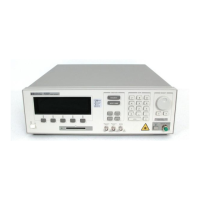C
Relative intensity noise
(RIN):
The square of the RMS optical power amplitude divided by the
measurement bandwidth and the square of the average optical
power, expressed in dB/Hz.
Conditions:
coherence control o, temperature within operating
temperature range, frequency range 0.1 to 6 GHz.
Measurement
with HP lightwave signal analyzer.
Relative wavelength
accuracy:
When randomly changing the wavelength and measuring the
dierences between the actual and displayed wavelengths, the
relative wavelength accuracy is
6
half the span between the
maximum and the minimum value of all dierences
.
Conditions:
uninterrupted TLS line voltage, constant power level,
temperature within operating temperature range, coherence control
o.
Measurement
with wavelength meter.
Sidemode suppression
ratio:
The ratio of average signal power to the optical power of the highest
sidemode within a distance from 0.1 to 6 GHz to the signal's optical
frequency, expressed in dB.
Conditions:
at a specied output power and wavelength range,
temperature within operating temperature range, coherence control
o.
Measurement
with HP lightwave signal analyzer using heterodyning
method.
Source spontaneous
emission:
The ratio of spontaneous emission power in 0.1 nm bandwidth to
signal power within a
6
2 nm window around the signal wavelength,
at
!
maximum specied output power, expressed in dB per 0.1 nm.
Conditions:
at maximum specied output power, temperature within
operating temperature range, coherence control o.
Measurement
with optical spectrum analyzer at 0.1 nm resolution
bandwidth.
Wavelength range:
The range of wavelengths for which the specications apply.
Wavelength repeatability:
The uncertainty in reproducing the wavelength after detuning and
re-setting the wavelength. The wavelength repeatability is
6
half the
span between the maximum and the minimum value of all changes.
Conditions:
uninterrupted TLS line voltage, constant power level,
temperature within operating temperature range, coherence control
o.
Measurement
with wavelength meter.
Wavelength resolution:
The smallest possible displayed wavelength increment / decrement.
Wavelength stability:
The change of wavelength during a given time span, expressed as
6
half the span between the maximum and the minimum wavelengths.
Conditions:
uninterrupted TLS line voltage, constant wavelength-
and power level settings, coherence control o, temperature within
6
1 K, time span as specied.
Measurement
with wavelength meter
Specications C-3

